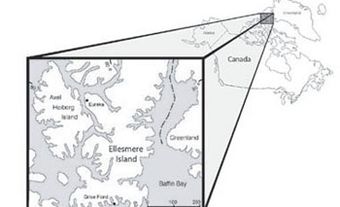Miguasha Fossils
About 380 million years ago during the Late Devonian, North America was connected to Europe, forming a large continent positioned on the equator and named Euramerica. At this time, a large and quiet estuary covered the small area now known as Miguasha, located on the southern side of the GASPE PENINSULA in Eastern Québec. This estuary was formed by the mix of fresh water from a river originating in the young Appalachians with saltwater. About 20 species of fish, some strange-looking, lived in these brackish waters. They included the agnathans or jawless fishes, the placoderms with their heavy armour and the acanthodians, which had spines. All reached the end of their reign in the waters of the world as another group, the actinopterygians, began to diversify. Also present in Miguasha, this group now represents 90% of extant fishes and includes species such as trout, cod and eel. A fifth group also inhabited the estuary, the sarcopterygians. This last group includes contemporary forms, such as the coelacanths and lungfishes, and also some species that are now extinct. The sarcopterygians have fleshy fins and, surprisingly, lungs as well in some cases.In addition to fishes, a few INVERTEBRATES, such as small CRUSTACEANS, worms and eurypterids, which are giant cousins of land scorpions, lived at the bottom of the estuary. On land, SCORPIONS that could reach one metre in length and millipedes lived under a vegetation dominated by progymnosperms, fernlike trees that are considered to be the ancestors of conifers and broadleaf trees. A striking difference from today was that not one land vertebrate, or tetrapod, existed at the time.
This Devonian ecosystem was eventually replaced by other environments less favourable to fossilization. However, it is preserved in FOSSIL-bearing sandstones and shales. As the geological history of the area unfolded over millions of years, the fossil-bearing rocks became exposed in the cliffs of Miguasha.
The natural erosion of these cliffs led to the discovery of the first fossils in 1842 by Dr. Abraham GESNER, who was appointed by the Geological Survey of New Brunswick to find coal in the northwest part of this province. Gesner also investigated the Québecois side of the CHALEUR BAY and found plant and fish fossils at Miguasha. The event was soon forgotten, and it was not until a Geological Survey of Canada team rediscovered the site in 1879 that a real international interest developed. Over the decades, thousands of specimens have been extracted from the cliffs, first by American and European teams, then by Québecois teams, starting in 1937. Interest in the site led the Government of Québec to buy part of the fossil cliff in 1972. Since a museum was built in 1978, the focus on Miguasha has been oriented towards research, conservation and public education. The site has been part of Québec's parks since 1985.
The Miguasha National Park was designated a UNESCO WORLD HERITAGE SITE in 1999. This honour was granted because of the great quantity (18 000) of fossils found since the end of the 19th century, the exceptional state of conservation of the specimens, and the fact that they are representative of the Devonian geological era. The cliffs of Miguasha help to document a crucial step in the history of vertebrates on Earth, their transition from water to land. During the Devonian, some fishes acquired different features, such as strong fins and lungs, allowing them to adapt and survive out of the water. Two famous sarcopterygians from Miguasha, Eusthenopteron foordi and Elpistostege watsoni, probably played a role in this transition. Such species eventually gave birth to the first tetrapods, from which evolved the amphibians and reptiles and later, the birds and mammals. It is therefore a key moment of our own history that has been preserved for the last 380 million years in the rocks of Miguasha.
See alsoPALEONTOLOGY.

 Share on Facebook
Share on Facebook Share on X
Share on X Share by Email
Share by Email Share on Google Classroom
Share on Google Classroom


